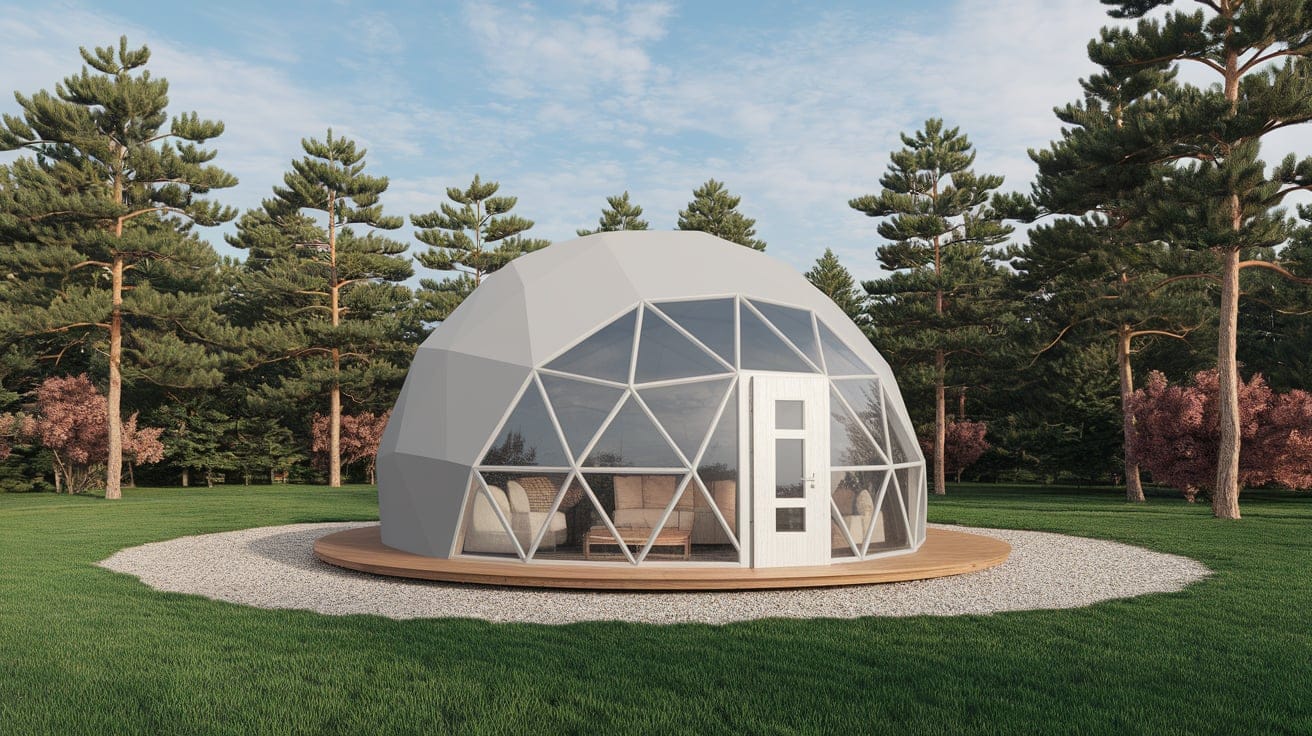Finding a home that’s both cost-effective and well-built feels almost impossible in today’s housing market. I know the struggle of watching prices climb while quality often takes a back seat.
That’s why I’m excited to share how geodesic dome homes offer a real solution to this housing challenge. These unique structures provide excellent strength, better space use, and meaningful energy savings compared to standard homes.
In this post, I’ll explain everything you need to know about building your own low-cost dome home.
From picking the right materials to understanding the key benefits, you’ll discover why these fascinating structures might be the smart housing choice you’ve been looking for.
What Are Geodesic Dome Homes?
Geodesic dome homes might look like something from a science fiction movie, but they’ve been around for decades. Buckminster Fuller created these unique structures after World War 2 as a solution to housing shortages.
I find their history fascinating because Fuller saw them as a way to help people find affordable, sturdy homes when they needed them most.
What makes these domes special is their design based on connecting triangles that form a rounded shape. This pattern isn’t just for looks – it creates one of the strongest building forms known.
The triangles distribute weight and stress evenly throughout the structure. Consider how an egg, despite being thin, can support surprising weight because of its shape.
Dome homes work on a similar idea, getting their strength from smart geometry rather than thick, costly materials.
Why Geodesic Domes Are the Future of Affordable Housing?
Geodesic Domes can save you real money both upfront and long-term. A dome uses about 25-30% less building materials than a box-shaped house with the same floor area. This means lower costs from day one, plus less waste during construction.
The savings continue after you move in, too. The dome shape allows air to flow naturally inside, keeping temperatures more even throughout the space. This means your heating and cooling systems don’t have to work as hard.
Some dome homeowners report cutting their utility bills by half compared to their previous standard homes.
What truly sets these structures apart is how they handle rough weather. Their rounded shape helps wind flow around them instead of pushing against flat walls, making them much more likely to stay standing during hurricanes or heavy storms.
Their design also spreads weight evenly, helping them resist earthquake damage better than many standard homes. In snowy areas, the shape prevents heavy snow buildup that can damage regular roofs.
Types of Dome Kits and Materials
When looking into affordable dome homes, I found several standout options that balance cost with quality. Here’s what you need to know about the main types available today:
1.Aircrete Domes
These use steel-reinforced concrete panels for maximum durability. I like that they’re fire-resistant and can last for generations. The concrete material also provides excellent insulation, keeping heating and cooling costs low year-round.
2. DomeGaia’s AirCrete
This is a lightweight mixture of cement and air bubbles. I appreciate how easy it is to work with—even after it hardens, it can be cut with basic woodworking tools. AirCrete is perfect for those who want to build their dome themselves without heavy equipment.
3. Geoship’s Bioceramic
These innovative domes mimic the chemistry of human bone. The material is non-toxic and incredibly strong. I was impressed by how they’re designed to be fireproof, hurricane-proof, and mold-proof – truly built to last through almost anything.
4. Ekodome’s Insulated PRO Series
These feature sandwich panels with excellent insulation. The metal frame provides a solid structure, while the insulated panels keep indoor temperatures stable. I found these to be a good middle-ground option that balances cost with comfort.
Price Range Comparison for Dome Home Kits
| Dome Type | Size Range | Price Range | Best For |
|---|---|---|---|
| AirCrete Dome Kits | 300-1,000 sq ft | $2,500-$15,000 | Budget DIY builders |
| Bioceramic Dome Systems | 360-1,430 sq ft | $33,000-$129,000 | Long-term sustainability |
| Basic Geodesic Kits | 200-800 sq ft | $5,000-$25,000 | Beginners and temporary structures |
| Insulated PRO Series | 250-700 sq ft | $12,000-$40,000 | Extreme weather locations |
| Wooden Frame Domes | 450-1,200 sq ft | $10,000-$45,000 | Natural aesthetic preference |
| Polycarbonate Panel Domes | 150-600 sq ft | $4,000-$20,000 | Greenhouse and bright spaces |
Geodesic Dome Homes: Benefits You Should Know
1. Energy Efficiency
I’ve researched how domes use space and found that their rounded shape has up to 30% less surface area than box homes of the same size. This means less area for heat to escape in winter or enter in summer.
Many dome owners tell me they’ve cut their heating bills almost in half!
2. Disaster Resistance
Having seen domes after storms, I can confirm they handle wild weather better than most homes. Their shape lets wind flow around them instead of pushing against flat walls.
Photos from Hurricane Katrina showed domes still standing while nearby houses were destroyed. They can also handle snow loads that would crush standard roofs.
3. Longevity
Depending on the materials, domes can outlast standard homes by decades. Concrete and bioceramic domes resist fire, won’t rot, and can’t be eaten by bugs. One dome owner told me, “I haven’t had to make a single repair in 15 years—not even a leak.”
4. Sustainability
Most dome kits work perfectly with green systems. I’ve visited domes running fully on solar power with rainwater collection. The materials themselves can be earth-friendly too – wood from managed forests, plant-based insulation, or even soil-based building methods.
Keeping Your Dome in Top Shape: Maintenance Tips
Dome homes need less upkeep than standard houses, but they still need care:
1. Seam Checks
Inspect all panel joints and seals once a year without fail. Use a quality sealant on any gaps you find. This small task stops water damage before it starts. Look closely at areas where different materials meet, as these spots often crack first. Bad seals waste heat and money in winter months.
2. Ventilation
Keep air moving through your dome to stop dampness. Clean the vents and fans every six months for best results. Check that intake and output vents remain clear of dust and bugs. Good airflow fights mold growth in the unique dome shape. Most kits come with vent plans fitted to the dome’s needs.
3. Exterior Finish
Your dome’s outer layer needs checks based on what it’s made of. Wood needs stain or paint every few years. Metal parts might need rust checks. Concrete needs crack exams. Some finish types last up to ten years before needing work. Use products made for your dome’s material type.
4. Foundation Inspection
When snow melts, walk around your dome to look for foundation issues. Small cracks can grow if not fixed early. Check that water drains away from your dome on all sides. Look for soil that sinks near the walls. A solid base keeps your whole dome safe for years to come.
Final Thoughts
Living in a geodesic dome home offers a smart path forward for anyone tired of the housing market squeeze. These structures aren’t just affordable – they’re practical solutions for our changing world.
Why does this matter? As housing costs climb and climate concerns grow, dome homes provide a way to live comfortably while reducing both your bills and environmental impact.
Ready to explore dome living? Start by researching local building codes in your area, then reach out to kit makers for sample plans. Many companies offer virtual tours or workshops where you can experience dome homes firsthand.
The future of housing doesn’t have to be expensive or cookie-cutter. With geodesic domes, you can build a home that’s as unique as you are – without breaking the bank.
Frequently Asked Questions
1. How Long Does It Take to Build a Geodesic Dome Home?
Most small to medium dome kits can be assembled in 2-7 days with a team of 3-4 people.
2. Are Homes Hard to get for dome homes?
No, most quality kit makers provide engineering documents that meet standard building codes.
3. Can Dome Homes Have Normal Furniture?
Yes, regular furniture works fine – the curved walls only affect placement near the edges.
4. Do Dome Homes Handle Extreme Weather Well?
They excel in harsh conditions, with some models tested to withstand winds up to 200 mph.














One Comment
Hi im enquiry about dome homes